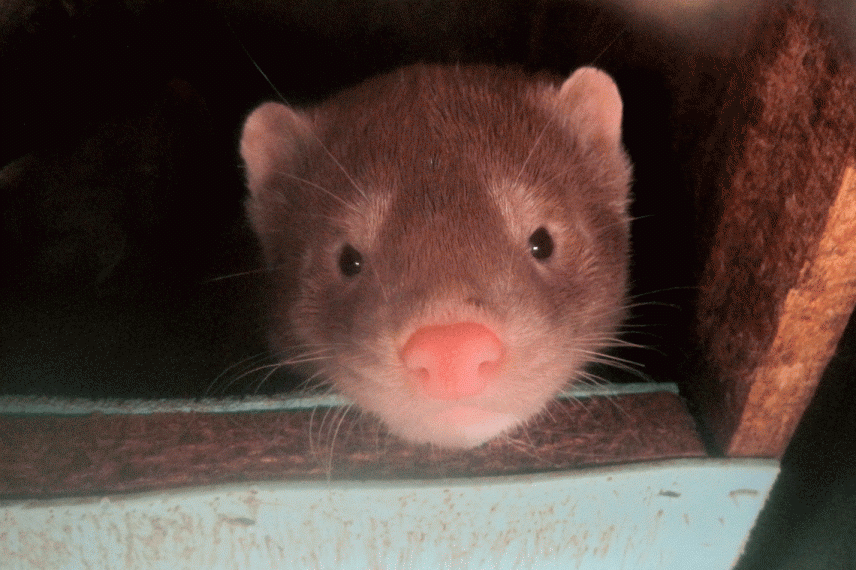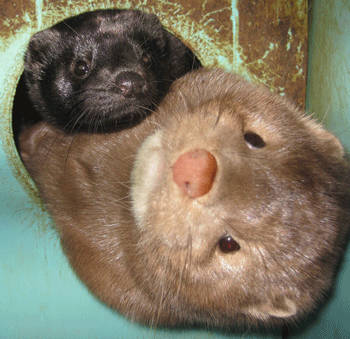Research relationships focus on mink mating

We know more about mink sexual development thanks to University of Guelph researchers and local mink farmers. It may not be a “romantic” topic for Valentine’s Day, but it is certainly a story about relationships.
Lead researcher Jamie Ahloy Dallaire and Prof. Georgia Mason, Department of Animal Biosciences, found that young male mink who spent more time playing as juveniles showed more vigorous sexual performance as adults.
The research began in 2011 with a hypothesis that rough-and-tumble play could help juvenile mink prepare for adult sexual behaviour. A hypothesis Ahloy Dallaire developed after reading a book by Sergio and Vivien Pellis where they observed that the specific maneuvers used in rough-and-tumble play by young rats resemble those that adults use during courtship and mating, not during aggressive fighting. He also drew inspiration from older observations that young males of many species, including rats and mink, who are raised without play partners tend to become sexually incompetent adults to develop his hypothesis.
“Rough-and-tumble play is commonly known as ‘play fighting’, but at least in some species it might be more appropriate to think of it as ‘play mating’,” says Ahloy Dallaire, who recently completed his PhD at the University of Guelph and is now working at Stanford University in the Department of Comparative Medicine.
Industry relationships important for impactful research

Ahloy Dallaire (left) turned his hypothesis into research by working with Prof. Mason who is a world-renowned animal welfare and behaviour scientist.
Taking advantage of Mason’s industry connections, he teamed up with the Millbank Fur Farm in the summer of 2011 and the RBR Fur Farm in 2012. He worked with both farms, and hundreds of mink, until 2014. Both are family operations run by the Parkinson (Millbank Fur Farm) and Rankin (the RBR Fur Farm) families.
Working directly with producers was important for Ahloy Dallaire for many reasons including logistics, cost, lessening the impact on animals and knowledge.
“Farmers really know their animals,” he says. “They have decades of experience managing mink, which means they are able to give us advice and offer insights that end up being invaluable for how we do our research.”
Collaborative work with producers is also crucial for animal welfare researchers if they are to make a lasting impact. Ahloy Dallaire believes that collaboration with industry is one of the primary ways researchers like himself are able to produce results that are applicable to the actual conditions in the industry and ultimately lead to change in the industry.
“While working in your own lab gives you a lot of room to try all sort of different things, farmers will be quick to tell you what is actually practical or not,” he explains. “Having a relationship of trust with farmers also goes a long way toward being able to have your research findings paid attention to and acted on by people within the industry.”
These collaborations are valued by mink producers as well.
"It's been very beneficial to the industry to collaborate with experts in behaviour and welfare," says Gary Hazlewood, Executive Director of the Canada Mink Breeders. "We're also very glad to help design experiments and appreciate the chance to provide input to research. It is amazing what you can do when you work together."
These types of partnerships lead to trust, knowledge and ultimately the improvement of animals’ lives. In 2013, collaboration between researchers, including Prof. Mason’s team, and producers led to changes in the National Farm Animal Care Council Code of Practice for the Care and Handling of Farmed Mink.
Mink roughhousing improves sexual performance

Over the three-year research period, Ahloy Dallaire observed juvenile mink at the farms spending much of their time biting each other, sparring with their forepaws, wrestling, and pushing and chasing each other. Some young mink when given toys also fought while competing for the objects or played a kind of tug-of-war.
He later observed that the most playful juveniles grew into adult males who copulated for the longest average durations.
Ahloy Dallaire explains that mink sexual activity can appear fairly violent, so elements of rough-and-tumble play could be practice for mating behaviour. Males and females typically fight each other before mating, and females struggle to escape during bouts of copulation that can last upwards of an hour.
He believes that long copulations are likely to be beneficial for males in the evolutionary struggle, as they may give males an edge in sperm competition, making them more likely to fertilize a female’s eggs than her other mates.
Better understanding breeding is a fundamental question for producers who are interested in productivity on their farms, but it was also a fundamental scientific question for Ahloy Dallaire.
“I sought to understand why on earth play would have evolved,” shares Ahloy Dallaire. “It seems like a frivolous behaviour that doesn't in any obvious way help animals survive or reproduce.”
Thankfully his research, published in the January 2017 issue of Animal Behaviour, points to some answers for this behaviour and its evolutionary role in mink.